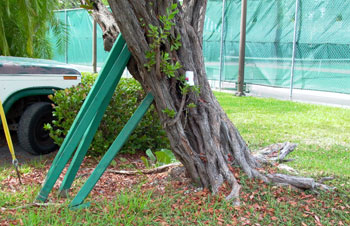Home > Tree structure basics > Distributing loading
Distributing load on stems and branches

 End
loading: When most of the canopy is at the top of the tree
or when most of the foliage on a branch is at the end of the branch the tree
is prone to failure. The wind load is dissipated in the tree when some branches
are attached to the lower trunk and some are on the lower part of the main branches.
This helps distribute wind load and minimize breakage (right photo).
End
loading: When most of the canopy is at the top of the tree
or when most of the foliage on a branch is at the end of the branch the tree
is prone to failure. The wind load is dissipated in the tree when some branches
are attached to the lower trunk and some are on the lower part of the main branches.
This helps distribute wind load and minimize breakage (right photo).
Unbalance
in canopy: A tree is not as stable when most of the branches are on one
side of the tree and the tree is leaning (see left photos). Check this tree
for signs of roots lifting the soil on the side opposite the lean, cracks in
the trunk, and other signs that the tree is failing. Consider removing the tree
or reducing the size of the canopy.
Trunk taper: Trunks that are about the same diameter for long distances are considered poorly tapered (lower right photo). Trees with this trunk type are prone to failure, especially when surrounding trees are removed.
Trunk hot spot: The point between the root flare and the point where the lowest main branches attach to the trunk is considered a hot spot for failure. Be vigilant about checking this area for defects.

